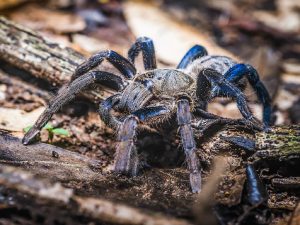Cobalt Blue Tarantula
Cyriopagopus lividum

Cobalt Blue Tarantulas are native to South East Asia, from countries such as Myanmar, Thailand, Laos, Singapore, Cambodia and Vietnam.
They often appear as dark coloured, but under the right
lighting, the fantastic cobalt blue sheen on their legs is easy to see.
This species doesn’t have irritating hairs for it to flick into the faces of its enemies, so the only weapons you have to worry about are its fangs.
Cobalt Blue Tarantulas require quite specific care conditions so should only be kept by those with experience in keeping arachnids.
These spiders can be very aggressive when they feel threatened and are quick to bite. Luckily their venom is quite weak on humans, and feels like a wasp sting.
Latin Name: Cyriopagopus lividum
Difficulty Level: Expert
Temperament: Aggressive
Life Span: 5 – 10 Years – Male ¦ 20 – 25 Years – Female
Size: Up to 13cm Leg Span (Females are larger)
Habitat South East Asia – Jungle Floor.
Diet: Live Insects such as Locusts and Crickets.
Feed 1 – 3 times per week.
Avoid Frozen or Dead Food.
Supplements: None.
Hours of Activity Nocturnal – Cobalt Blue Tarantulas are more likely to be active at night, but will take prey at any time.
Handling: Do not handle. If you need to move the spider for any reason, use thick gloves to avoid getting bitten.
Temperature: 20°C – 23°C
Humidity: 70% – 80%
Vivarium Size: 10 – 20 Gallon
Substrate Type: Blend of Soil, Moss, Coconut Fibre and Cork.
Equipment Necessary: Tank, Spray bottle to keep the substrate moist. Heat Mat, Thermostat.
Cleaning Instructions: Spot clean any uneaten food and remains. Clean substrate once per month to avoid bacterial growth.
Healthy Behaviour: Coming out of their burrow at night to hunt, Feeding well.
Sick Behaviour: Not feeding, Lethargy.
You must provide fresh, clean water daily. This can be done via misting.
Give the spider at least 8 inches of substrate in which to make its lair. These Tarantulas are avid burrowers.
Cobalt Blue Tarantulas moult once or twice per year. This can take anywhere from minutes to hours.
Whilst moulting, it may look like the spider is dying. They tend to stop eating in the days leading up, then roll over onto their backs before the process begins.
Do not touch the spider while it is moulting. This can kill the spider due to stress and shock. They are very vulnerable during and after moulting, so may display even more aggression.
Like a lot of spiders, the Male is at serious risk of being eaten when trying to mate. If you attempt to breed your spiders, be sure to remove the Male as soon as the deed is done, lest he become the Female’s dinner.
Sometimes this is unavoidable, as if the Female isn’t receptive to his advances, she will see him as prey and attack.
If the spider feels threatened, it will stamp its feet before rearing onto its hind legs with its forelegs in the air, bearing its fangs menacingly. Other times it will just bite without any warning.
Common Problems:
Escaping – Be sure to have a nice tight lid on the tank as these spiders are expert escape artists and the last thing you want is an aggressive, venomous spider roaming about your house.
Dehydration: Cobalt Blue Tarantulas must stay hydrated with both fresh water and adequate humility levels, otherwise they will dry out and quickly perish.
